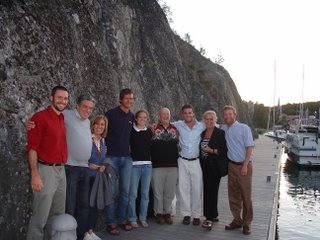May 10th, 2006
May 10th, 2006 (10:30 PM EST)
Providence, RI, USA
Greetings Readers,
Now that we are only a few short weeks away from our departure date I thought that it was about time to get this blog rolling and figured that there would be no better way to jump start than with my reaction to the incredible maps that Sophie has recently put together for us.
Looking at them on the website I was suddenly made very aware of how close we are to making this trip a reality. Having talked and thought about it almost non stop for the last few months it had gotten to a point where the whole trip had started to seem overly vague and theoretical. I was so focused on the little tasks that are involved in fundraising and planning for a trip like this that I had lost the larger view of what we were going to do.
Thankfully, our new maps have given me back some of my lost perspective and I am looking at things with new eyes.
It has also helped that I have been reading through Vinci's text over the last few days and am now seeing some of the connections that had eluded me earlier.
One that stands out in particular is the power of the "maelstrom" as physical evidence of Vinci's theory.
In the course of his attempts to return home one of the major obstacles that Ulysses encounters is Charybdis, the maelstrom which threatens to destroy his boat and drown his crew. Although he is able to escape his first encounter by sailing close to the cliffs of Scylla (and sacrificing some of his men), his battered ship is later blown back to the maelstrom and Ulysses is only able to survive by hanging onto a "fig tree" (Vinci postulates that the "fig tree" was actually a particularly thick type of seaweed found along the coast in Atlantic waters that was altered to conform to the new environment during later renditions of the story) until the suction of the maelstrom abates and the remnants of his ship are regurgitated out into the surrounding waters.
What is truly amazing about this passage is that its description, though likely exaggerated for literary purposes, describes a real environmental phenomenon. A phenomenon which, incidentally, can be found in the coastal waters outside Norway where the variation in tides create just such a whirlpool several times throughout the day.
This and other details are the kinds of evidence that makes this trip so exciting. To be able to retrace a voyage that took place over 2,000 years ago is a truly remarkable opportunity and it is this type of evidence that gives many historians faith that Homer's tales are based on references to real events.
By moving the setting of these classic tales from the Mediterranean to the Baltic it suddenly becomes possible to see the events and characters in the stories in a new light. This altered perspective is what I am looking forward to exploring in the course of our journey, and I hope that by publicizing our progress along the way we are able to interest others in our search as well.
So keep checking in and tell others to tune in as well. It should be quite a trip.
-Caleb


0 Comments:
Post a Comment
<< Home